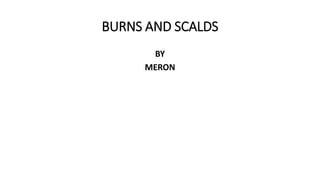
BURNS IN FIRST AID.pptx
- 2. Definitions Burns and scalds are damage to the skin caused by heat. A burn is caused by dry heat, for example by an iron or fire. Burns may also be caused by chemicals and electricity. A scald is caused by something wet, such as hot water or steam.
- 3. Types of burns and their possible causes 1. Dry burns caused by flames, contact with hot objects such as flat irons and friction e.g. rope burns. 2. Electrical burns caused by lightening and low volted currents used by domestic appliances/ high volted currents 3. Chemical burns caused by bleaching agents, weed killers, corrosive acids and alkalis, industrial chemicals including fumes and corrosive gases, domestic chemicals and agents such as caustic soda 4. Radiation burns caused sun heat, over exposure to radioactive substances like x-rays, over exposure to ultra violent rays from the sun lamp.
- 4. People at high risk of sustaining burns • Young children below 5 years • Epileptic patients • Leppers ( people suffering from leprosy) • House helpers • Factory workers • Advanced age • Mentally ill patients
- 5. Classification of burns • The extent of Burns is assessed according to the percentage of the body affected basing on the rule of nine for adults and rule of seven for children. • This helps to confirm the need for hospitalisation i.e. (≥ 10% and ≥ 15% for children and adults respectively ) • Burns are classified in terms of degrees i.e. the burn itself. • This classification is based on the different layers of the skin that may be involved in the burns.
- 6. 1st degree burns ( superficial burns) • Only the outer most layer of the skin ( epidermis) is affected. • This class of burns presents with; Erythema Swelling Tenderness
- 7. 2nd Degree Burns ( partial thickness) • This involves the epidermis and sometimes part of the dermis. • The affected skin; Becomes red and raw Forms blisters ( due to fluid release from damaged tissue) Is painful and tender due to damage of nerve endings. They need medical attention; for infection and dehydration may result.
- 8. 3rd Degree burns ( Full thickness) • This fully affects all the layers of the skin and there may be damage to the nerves, fat tissue, muscles and blood vessels. The skin may look waxy and pale. • Pain sensation is usually lost and this marks the severity of the injury NB: Urgent medical attention is very essential.
- 9. BURNS WHICH REQUIRE HOSPITAL TREATMENT. • If a causality is a child, medical advice should be sought no matter the size and depth of the burn. • For adults, medical attention should be sought in the following cases; All full thickness burns i.e. 3rd degree burns All burns involving the face, hands, feet or genital area. Burns comprising of mixed pattern of varying depth.
- 10. Assessment of the percentage of burns • In adults, the percentage of burns is estimated using Wallace’s rule of nine. Part of the body Percentage of the body Head and neck 9 Each upper limb ( arm) ( 9×2) 9 Each lower limb (leg) ( 18×2) 18 The anterior trunk ( front trunk) 18 Posterior trunk ( back trunk) 18 The genital area 1
- 11. • In children, the percentage of burns is estimated using the rule of seven.Part of the body Percentage of the body Head and neck 28 Each upper limb ( arm) 7 Each lower limb (leg) 14 The anterior trunk ( front trunk) 14 Posterior trunk ( back trunk) 14 The genital area 2